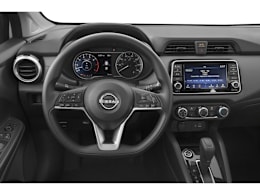The Nissan Versa has always been an unabashedly inexpensive car, but the most recent redesign at least adds a layer of visual pizzazz that makes it seem less spartan. In addition to the new look, the updated Versa also benefits from standard automatic emergency braking (AEB), but the brittle ride, vague steering, and uneven interior quality are disappointing—even for a budget car. The hatchback version of the Versa, known as the Versa Note, has been discontinued.
Like most subcompacts, the Versa is inexpensive to purchase and easy to park. But its small size doesn’t give any benefit to fuel economy. We got 32 mpg overall in our tests, which is the same as the much larger Toyota Camry, and the more versatile Nissan Kicks. The Hyundai Elantra—a compact car that we recommend—gets 33 mpg overall.
As part of the redesign, Nissan bumped the horsepower count of the Versa’s four-cylinder engine up to 122 from 109. Still, the car feels like it’s running out of breath when climbing a hill or merging into fast-moving traffic. That said, the continuously variable transmission (CVT) does a good job of mimicking a conventional transmission and contributes to the Versa’s predictable, uninterrupted acceleration. Unless the engine is working hard, the Versa is noticeably relaxed in around-town driving. There's some road and wind noise, but that’s to be expected from a car in this price range.
The Versa’s suspension does a lousy job isolating occupants from bumps and potholes, and the ride gets quite brittle over rough pavement. Steering feel is dull, which contributes to the mundane handling that makes the car rather boring to drive. At least it remains secure when pushed to its limits.
Controls are easy to use. Buttons and knobs are simple and the touch screen infotainment system is clear and intuitive. Visibility is good out the windshield and side windows, but the high rear package shelf obscures some aft visibility.
Long trips in the Versa are no joy. The basic driver's seat is short on back support. Unlike the previous Versa, which had an amazingly roomy rear seat for its size, the rear is now rather cramped and has tight legroom. While the optional soft-touch dashboard trim looks great, the carbon-fiber-look plastic on the doors is a sporty flourish that’s out of place in a basic sedan, and it detracts from the interior’s appearance.
We’re happy that Nissan gave every Versa forward collision warning (FCW) and AEB. Having these safety features is arguably the only reason to get a Versa over its competitors or a more substantial used car.


























